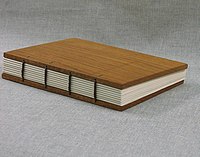
Coptic binding or Coptic sewing comprises methods of bookbinding employed by early Christians in Egypt, the Copts, and used from as early as the 2nd century AD to the 11th century.[1][note 1][2] The term is also used to describe modern bindings sewn in the same style.
Coptic bindings, the first true codices, are characterized by one or more sections of parchment, papyrus, or paper sewn through their folds, and (if more than one section) attached to each other with chain stitch linkings across the spine, rather than to the thongs or cords running across the spine that characterise European bindings from the 8th century onwards. In practice, the phrase "Coptic binding" usually refers to multi-section bindings, while single-section Coptic codices are often referred to as "Nag Hammadi bindings", after the 13 codices found in 1945 which exemplify the form.
- ^ Turner, Eric G. (1977). The Typology of the Early Codex. University of Pennsylvania Press. pp. 89–94. ISBN 0-8122-7696-5.
- ^ Greenfield, Jane (2002). ABC of bookbinding: a unique glossary with over 700 illustrations for collectors and librarians. New Castle (Del.) Nottingham (GB): Oak Knoll press The Plough press. p. 81. ISBN 978-1-884718-41-0.
Cite error: There are <ref group=note> tags on this page, but the references will not show without a {{reflist|group=note}} template (see the help page).